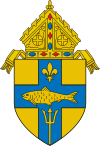Herman Joseph Alerding
St. Meinrad Seminary St. Thomas Seminary |
|---|

Herman Joseph Alerding (April 13, 1845 – December 6, 1924) was a German-born American prelate of the
Biography
Early life
Herman Alerding was born on April 13, 1845, in Kingdom of Westphalia (in what is today Germany).[1] After his birth, the family immigrated to the United States, settling in Newport, Kentucky.[2] He attended the parochial school of Corpus Christi Parish.[3] Alerding decided to become a priest, but Bishop George Carrell, the prelate for the local Diocese of Covington, refused to send him to seminary. Carrell did not want to pay Alerding's seminary tuition.
However, in 1858, Bishop
After receiving the
Priesthood
Alerding was ordained to the
Alerding was transferred to St. Joseph Parish in
Bishop of Fort Wayne
On August 30, 1900, Alerding was appointed the fourth bishop of the Diocese of Fort Wayne by
During World War I, Alerding established the Fort Wayne Diocesan War Council.[4] In a pastoral letter issued in December 1918, Alerding declared, "We deserved the infliction of this terrible war and its awful consequences."[4] Under Alerding's administration, the number of diocesan priests nearly doubled from 109 in 1900 to 210 in 1925.[4] In 1900, the diocese had 102 churches with resident pastors, 39 mission churches, and 73 parochial schools; in 1924, there were 148 churches with resident pastors, 31 mission churches, and 106 parochial schools.[4]
Death and legacy
On November 29, 1924, Alerding suffered three broken ribs when his car collided with a streetcar in Fort Wayne. Already weakened by diabetes, he never recovered from the accident. Herman Alerding died in Fort Wayne on December 6, 1924, at age 79.[1][6] He was buried at the Cathedral of the Immaculate Conception in Fort Wayne.[7]
References
- ^ a b c "Bishop Herman J. Alerding". The New York Times. Retrieved 2022-11-18.
- ^ a b c d "Fort Wayne". Catholic Encyclopedia.
- ^ a b c d e Alerding, Herman Joseph (1907). The Diocese of Fort Wayne. Fort Wayne: The Archer Printing Company.
- ^ a b c d e f g h i White, Joseph M. (2007). Worthy of the Gospel of Christ: A History of the Catholic Diocese of Fort Wayne-South Bend.
- ^ a b c "Bishop Herman Joseph Alerding". Catholic-Hierarchy.org.
- ^ a b c "The Catholic Telegraph 11 December 1924 — Catholic Research Resources Alliance". thecatholicnewsarchive.org. Retrieved 2022-08-11.


